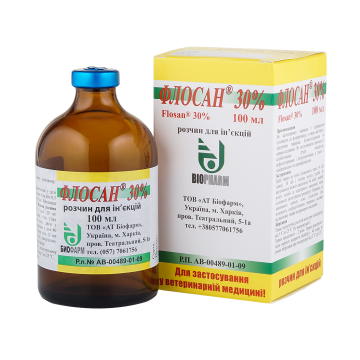FLOSAN® 30%
solution for injections
Description
Light-yellow transparent viscous solution.
Composition
1 ml of the drug contains:
active ingredient: florfenicol – 300 mg;
Excipients: propylene glycol, PEG-400.
solution for injections
Description
Light-yellow transparent viscous solution.
Composition
1 ml of the drug contains:
active ingredient: florfenicol – 300 mg;
Excipients: propylene glycol, PEG-400.
Pharmacological properties
ATCvet: QJ01– antibacterials for systemic use. QJ01BA90 - Florfenicol.
Florfenicol is a synthetic broad-spectrum antibiotic, a derivative of thiamfenicol. The mechanism of action consists in inhibition of microbial cell peptidyl transferase enzyme activity, particularly in the area of 70 S ribosomes. Florfenicol is effective against gram-positive (Staphylococcus spp., Streptococcus spp.) and gram-negative (Pasteurella spp., Actinobacillus pleuropneumoniae, Bordetella bronchiseptica, Salmonella spp., Escherichia coli, Proteus spp., Haemophilus spp., Shigella spp., Klebsiella spp., Enterobacter spp., Aeromonas salmonicida, Campylobacter spp., Edwardsiella ictaluri, Edwardsiella tarda, Flexibacter spp., Pseudotuberculosis, Vibrio spp.) microorgnisms, as well as mycoplasmas (Mycoplasma spp.).
After parenteral administration, florfenicol is well absorbed in organs and tissues, reaching concentrations of 4-8 μg/g in lungs, heart, pancreatic gland, skeletal muscles and spleen. Relatively high concentrations are present in bile, kidneys, small intestine and urine. Urinary metabolites are composed of florfenicolamine, florfenicol oxamic acid and monochloroflorfenicol. Florfenicol and its metabolites are also excreted in feces. Florphenicolamine is the most long-term metabolite present in liver. About 64% of florfenicol is biotransformed into florfenicol amine. Half-life of florfenicol makes 2.6-3.2 hours on average. Florfenicol is primarily excreted in urine (up to 50%) unchnged.
Administration
Cattle: treatment of animals against interdigital necrobacillosis, keratoconjuctivitis as well as diseases of respiratory organs caused by florfenicol-sensitive microorganisms.
Swine: treatment of animals against interdigital necrobacillosis, keratoconjuctivitis as well as diseases of respiratory organs caused by florfenicol-sensitive microorganisms.
Dosage
Swine: 15 mg of florfenicol per 1 kg body weight intramuscularly (0.5 ml of the drug per 10 kg body weight). Repeat injection in 48 hours;
Cattle: 20 mg of florfenicol per 1 kg body weight intramuscularly (1 ml of the drug per 15 kg body weight) twice with an interval of 48 hours or 40 mg of florfenicol per 1 kg body weight subcutaneously (2 ml of the drug per 15 kg body weight) once.
Administer maximum 10 ml of the drug per single injection site.
Contraindications
Do not administer to animals with hypersensitivity to florfenicol.
Do not use in animals with severe renal or hepatic insufficiency.
Do not administer to pregnant and lactating animals, stud bulls and breeding boars.
Do not use in combination with antibiotics of the penicillin group, cephalosporins and fluoroquinolones as well as thiamfenicol and chloramfenicol.
Do not use in combination with with sulfonamide drugs.
It is not allowed to mix the drug in one syringe with other drugs.
Precautions
Side effect
If the drug is administered in recommended doses, side effects do not appear.
Possible allergic reactions. In case of allergic reactions, the drug is discontinued and antihistamines are prescribed to the animal; if necessary, administer symptomatic treatment.
Possible loss of appetite, decreased water intake, diarrhea, occurring for a short period after treatment.
Occasional redness and swelling re observed at the injection site.
Special precautions for administration
Do not prescribe the drug in sub-therapeutic doses and animals with hypersensitivity to the drug components.
Administration in pregnancy and lactation.
Do not administer in pregnant or lactating animals.
Excretion (withdrawal) period
Animal slaughter for meat is possible as follows: swine – in 14 days, cattle in case of intramuscular administration – in 30 days, cattle in case of subcutaneous administration – in 44 days following the last administration of the drug. Meat, obtained before the mentioned term, shall be utilized or fed to non-productive animals depending on the statement of a veterinary physician.
Packaging
Glass vials of 10, 50 and 100 ml sealed with rubber stoppers and aluminum caps.
Storage
Store in a dry dark place out of reach of children at 15-25 °С. Do not freeze!
Shelf life - 2 years.
48 hours after initial opening (sampling) if stored at 2-8 °С.
For use in veterinary medicine!
